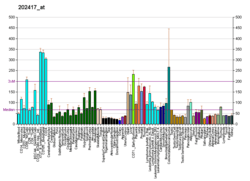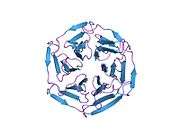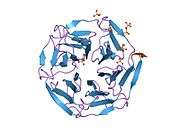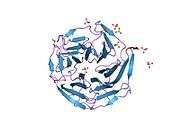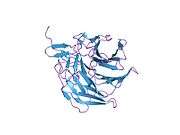KEAP1
Kelch-like ECH-associated protein 1 is a protein that in humans is encoded by the Keap1 gene.[5]
Structure
Keap1 has four discrete protein domains. The N-terminal Broad complex, Tramtrack and Bric-à-Brac (BTB) domain contains the Cys151 residue, which is one of the important cysteines in stress sensing. The intervening region (IVR) domain contains two critical cysteine residues, Cys273 and Cys288, which are a second group of cysteines important for stress sensing. A double glycine repeat (DGR) and C-terminal region (CTR) domains collaborate to form a β-propeller structure, which is where Keap1 interacts with Nrf2.
Interactions
Keap1 has been shown to interact with Nrf2, a master regulator of the antioxidant response, which is important for the amelioration of oxidative stress.[6][7][8]
Under quiescent conditions, Nrf2 is anchored in the cytoplasm through binding to Keap1, which, in turn, facilitates the ubiquitination and subsequent proteolysis of Nrf2. Such sequestration and further degradation of Nrf2 in the cytoplasm are mechanisms for the repressive effects of Keap1 on Nrf2.
As a drug target
Because Nrf2 activation leads to a coordinated antioxidant and anti-inflammatory response, and Keap1 represses Nrf2 activation, Keap1 has become a very attractive drug target.[9][10][11][12]
A series of synthetic oleane triterpenoid compounds, known as antioxidant inflammation modulators (AIMs), are being developed by Reata Pharmaceuticals, Inc. and are potent inducers of the Keap1-Nrf2 pathway, blocking Keap1-dependent Nrf2 ubiquitination and leading to the stabilization and nuclear translocation of Nrf2 and subsequent induction of Nrf2 target genes. The lead compound in this series, bardoxolone methyl (also known as CDDO-Me or RTA 402), was in late-stage clinical trials for the treatment of chronic kidney disease (CKD) in patients with type 2 diabetes mellitus and showed an ability to improve markers of renal function in these patients. However, the Phase 3 trial was halted due to safety concerns.
References
- 1 2 3 GRCh38: Ensembl release 89: ENSG00000079999 - Ensembl, May 2017
- 1 2 3 GRCm38: Ensembl release 89: ENSMUSG00000003308 - Ensembl, May 2017
- ↑ "Human PubMed Reference:".
- ↑ "Mouse PubMed Reference:".
- ↑ "Entrez Gene: KEAP1 kelch-like ECH-associated protein 1".
- ↑ Cullinan SB, Zhang D, Hannink M, Arvisais E, Kaufman RJ, Diehl JA (Oct 2003). "Nrf2 is a direct PERK substrate and effector of PERK-dependent cell survival". Mol. Cell. Biol. 23 (20): 7198–209. doi:10.1128/mcb.23.20.7198-7209.2003. PMC 230321. PMID 14517290.
- ↑ Shibata T, Ohta T, Tong KI, Kokubu A, Odogawa R, Tsuta K, Asamura H, Yamamoto M, Hirohashi S (Sep 2008). "Cancer related mutations in NRF2 impair its recognition by Keap1-Cul3 E3 ligase and promote malignancy". Proc. Natl. Acad. Sci. U.S.A. 105 (36): 13568–73. doi:10.1073/pnas.0806268105. PMC 2533230. PMID 18757741.
- ↑ Wang XJ, Sun Z, Chen W, Li Y, Villeneuve NF, Zhang DD (Aug 2008). "Activation of Nrf2 by arsenite and monomethylarsonous acid is independent of Keap1-C151: enhanced Keap1-Cul3 interaction". Toxicol. Appl. Pharmacol. 230 (3): 383–9. doi:10.1016/j.taap.2008.03.003. PMC 2610481. PMID 18417180.
- ↑ Abed DA, Goldstein M, Albanyan H, Jin H, Hu L (2015). "Discovery of direct inhibitors of Keap1-Nrf2 protein-protein interaction as potential therapeutic and preventive agents". Acta Pharm Sin B. 5 (4): 285–99. doi:10.1016/j.apsb.2015.05.008. PMC 4629420. PMID 26579458.
- ↑ Lu MC, Ji JA, Jiang ZY, You QD (2016). "The Keap1-Nrf2-ARE Pathway As a Potential Preventive and Therapeutic Target: An Update". Med Res Rev. 36 (5): 924–63. doi:10.1002/med.21396. PMID 27192495.
- ↑ Deshmukh P, Unni S, Krishnappa G, Padmanabhan B (2017). "The Keap1-Nrf2 pathway: promising therapeutic target to counteract ROS-mediated damage in cancers and neurodegenerative diseases". Biophys Rev. 9 (1): 41–56. doi:10.1007/s12551-016-0244-4. PMC 5425799. PMID 28510041.
- ↑ Kerr F, Sofola-Adesakin O, Ivanov DK, Gatliff J, Gomez Perez-Nievas B, Bertrand HC, Martinez P, Callard R, Snoeren I, Cochemé HM, Adcott J, Khericha M, Castillo-Quan JI, Wells G, Noble W, Thornton J, Partridge L (2017). "Direct Keap1-Nrf2 disruption as a potential therapeutic target for Alzheimer's disease". PLoS Genet. 13 (3): e1006593. doi:10.1371/journal.pgen.1006593. PMC 5333801. PMID 28253260.
Further reading
- Zhang DD (2007). "Mechanistic studies of the Nrf2-Keap1 signaling pathway". Drug Metab. Rev. 38 (4): 769–89. doi:10.1080/03602530600971974. PMID 17145701.
- Nagase T, Seki N, Tanaka A, Ishikawa K, Nomura N (1996). "Prediction of the coding sequences of unidentified human genes. IV. The coding sequences of 40 new genes (KIAA0121-KIAA0160) deduced by analysis of cDNA clones from human cell line KG-1". DNA Res. 2 (4): 167–74, 199–210. doi:10.1093/dnares/2.4.167. PMID 8590280.
- Itoh K, Wakabayashi N, Katoh Y, Ishii T, Igarashi K, Engel JD, Yamamoto M (1999). "Keap1 represses nuclear activation of antioxidant responsive elements by Nrf2 through binding to the amino-terminal Neh2 domain". Genes Dev. 13 (1): 76–86. doi:10.1101/gad.13.1.76. PMC 316370. PMID 9887101.
- Dhakshinamoorthy S, Jaiswal AK (2001). "Functional characterization and role of INrf2 in antioxidant response element-mediated expression and antioxidant induction of NAD(P)H:quinone oxidoreductase1 gene". Oncogene. 20 (29): 3906–17. doi:10.1038/sj.onc.1204506. PMID 11439354.
- Sekhar KR, Spitz DR, Harris S, Nguyen TT, Meredith MJ, Holt JT, Gius D, Marnett LJ, Summar ML, Freeman ML, Guis D (2002). "Redox-sensitive interaction between KIAA0132 and Nrf2 mediates indomethacin-induced expression of gamma-glutamylcysteine synthetase". Free Radic. Biol. Med. 32 (7): 650–62. doi:10.1016/S0891-5849(02)00755-4. PMID 11909699.
- Velichkova M, Guttman J, Warren C, Eng L, Kline K, Vogl AW, Hasson T (2002). "A human homologue of Drosophila kelch associates with myosin-VIIa in specialized adhesion junctions". Cell Motil. Cytoskeleton. 51 (3): 147–64. doi:10.1002/cm.10025. PMID 11921171.
- Zipper LM, Mulcahy RT (2002). "The Keap1 BTB/POZ dimerization function is required to sequester Nrf2 in cytoplasm". J. Biol. Chem. 277 (39): 36544–52. doi:10.1074/jbc.M206530200. PMID 12145307.
- Sekhar KR, Yan XX, Freeman ML (2002). "Nrf2 degradation by the ubiquitin proteasome pathway is inhibited by KIAA0132, the human homolog to INrf2". Oncogene. 21 (44): 6829–34. doi:10.1038/sj.onc.1205905. PMID 12360409.
- Bloom DA, Jaiswal AK (2004). "Phosphorylation of Nrf2 at Ser40 by protein kinase C in response to antioxidants leads to the release of Nrf2 from INrf2, but is not required for Nrf2 stabilization/accumulation in the nucleus and transcriptional activation of antioxidant response element-mediated NAD(P)H:quinone oxidoreductase-1 gene expression". J. Biol. Chem. 278 (45): 44675–82. doi:10.1074/jbc.M307633200. PMID 12947090.
- Cullinan SB, Zhang D, Hannink M, Arvisais E, Kaufman RJ, Diehl JA (2003). "Nrf2 is a direct PERK substrate and effector of PERK-dependent cell survival". Mol. Cell. Biol. 23 (20): 7198–209. doi:10.1128/MCB.23.20.7198-7209.2003. PMC 230321. PMID 14517290.
- Colland F, Jacq X, Trouplin V, Mougin C, Groizeleau C, Hamburger A, Meil A, Wojcik J, Legrain P, Gauthier JM (2004). "Functional proteomics mapping of a human signaling pathway". Genome Res. 14 (7): 1324–32. doi:10.1101/gr.2334104. PMC 442148. PMID 15231748.
- Kobayashi A, Kang MI, Okawa H, Ohtsuji M, Zenke Y, Chiba T, Igarashi K, Yamamoto M (2004). "Oxidative stress sensor Keap1 functions as an adaptor for Cul3-based E3 ligase to regulate proteasomal degradation of Nrf2". Mol. Cell. Biol. 24 (16): 7130–9. doi:10.1128/MCB.24.16.7130-7139.2004. PMC 479737. PMID 15282312.
- Strachan GD, Morgan KL, Otis LL, Caltagarone J, Gittis A, Bowser R, Jordan-Sciutto KL (2004). "Fetal Alz-50 clone 1 interacts with the human orthologue of the Kelch-like Ech-associated protein". Biochemistry. 43 (38): 12113–22. doi:10.1021/bi0494166. PMC 3670950. PMID 15379550.
- Li X, Zhang D, Hannink M, Beamer LJ (2005). "Crystal structure of the Kelch domain of human Keap1". J. Biol. Chem. 279 (52): 54750–8. doi:10.1074/jbc.M410073200. PMID 15475350.
- Zhang DD, Lo SC, Cross JV, Templeton DJ, Hannink M (2004). "Keap1 is a redox-regulated substrate adaptor protein for a Cul3-dependent ubiquitin ligase complex". Mol. Cell. Biol. 24 (24): 10941–53. doi:10.1128/MCB.24.24.10941-10953.2004. PMC 533977. PMID 15572695.
- Li X, Zhang D, Hannink M, Beamer LJ (2005). "Crystallization and initial crystallographic analysis of the Kelch domain from human Keap1". Acta Crystallogr. D. 60 (Pt 12 Pt 2): 2346–8. doi:10.1107/S0907444904024825. PMID 15583386.
- Furukawa M, Xiong Y (2005). "BTB protein Keap1 targets antioxidant transcription factor Nrf2 for ubiquitination by the Cullin 3-Roc1 ligase". Mol. Cell. Biol. 25 (1): 162–71. doi:10.1128/MCB.25.1.162-171.2005. PMC 538799. PMID 15601839.
- Hosoya T, Maruyama A, Kang MI, Kawatani Y, Shibata T, Uchida K, Warabi E, Noguchi N, Itoh K, Yamamoto M (2005). "Differential responses of the Nrf2-Keap1 system to laminar and oscillatory shear stresses in endothelial cells". J. Biol. Chem. 280 (29): 27244–50. doi:10.1074/jbc.M502551200. PMID 15917255.





